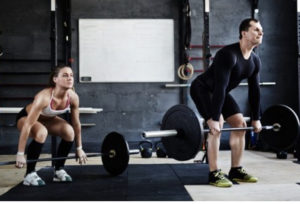Combining higher-load and lower-load resistance training exercises: A systematic review and meta-analysis of findings from complex training studies.
- PMID: 30683485
- DOI: 10.1016/j.jsams.2019.01.006
Abstract
Objectives: The aim of the present meta-analytical review was to determine the effectiveness of training programmes combining higher-load and lower-load exercises in one workout (i.e. complex training [CT]) on lower-body performance.
Design: Systematic review and meta-analysis.
Methods: A search of five electronic databases (PubMed, Web of Science, SportDiscus, CINAHL and Scopus) was conducted to identify all publications up to 7 March 2018. Meta-analyses were performed using a random-effects model with the dependent variables countermovement jump (CMJ) height, squat jump (SJ) height, one-repetition maximum (1-RM) squat performance and sprint time for 5m, 10m, 20m, 30m and 40m, respectively.
Results: The analysis comprised 33 studies and a total of 1064 healthy participants. The meta-analysis revealed that CT is effective in improving CMJ (95% confidence interval [CI] 5.6%-12.3%), SJ (95% CI 8.0%-17.4%), 1-RM squat (95% CI 16.4%-30.7%) and sprint performance (5m=95% CI -14.8% to -0.9%, 10m=95% CI -6.0% to -2.1%, 20m=95% CI -7.4% to -1.4%, 30m=95% CI -8.0% to -0.6%). However, when directly compared to traditional training methods, only 1-RM squat strength performance and 20m sprint time were superior following CT interventions (95% CI 0.2%-13.7% and 95% CI -1.6% to -0.1%, respectively) CONCLUSIONS: CT is an acceptable method for improving jump, strength and sprint performance in athletes. Compared to traditional training methods, CT seems to produce superior training effects only for 1-RM squat and 20m sprint performance; however, these findings were influenced by single studies and should be therefore interpreted with circumspection.
CORE Omaha Explains…
This is a nice meta analysis that sums up literature pretty well. It’s examining different complex loading programming for sports performance using lower body metric testing. The analysis comprised 33 studies and a total of 1064 healthy participants. The meta-analysis revealed that CT is effective in improving CMJ (95% confidence interval [CI] 5.6%-12.3%), SJ (95% CI 8.0%-17.4%), 1-RM squat (95% CI 16.4%-30.7%) and sprint performance (5m=95% CI -14.8% to -0.9%, 10m=95% CI -6.0% to -2.1%, 20m=95% CI -7.4% to -1.4%, 30m=95% CI -8.0% to -0.6%).
What does this all mean?
It means that using complex methods of training with high load and lower loading volume work is more effective to increase back squat and 20m sprint times to training just high volume or low volume high weight. This is an important finding for our athletes showing heavy loading is still very important, but high volume loading accessory work is also important and will give a much better overall response to sports performance metrics. In this meta analysis, 20 m sprint was effected the highest. I would argue 20 m sprint times are also one of the most underrated metric for testing athletes and their performance.
At CORE, we implement this strategy with overall sports performance training and post op rehab training as well. Its important to make sure we understand the differences and the benefits of different training methodology and how it relates to our patients. Thats were the Doctors of Physical Therapy come in. We single handedly will use our knowledge of the body and the resource that science and research give us. We use to implement the most efficient rehab protocols available. No two rehabs are identical. No two people are identical. No two sports are identical. No two surgeries are identical. This is what makes us different, fully custom rehab tailored to the individual, their goals, and the strengths/weaknesses.
C.O.R.E. Physical Therapy and Sports Performance PC,
is
owned and Operated
by
Dr. Mark
Rathjen and Dr. Claire Rathjen. CORE is a family owned business that has been established in
2015 and is proud to serve the greater Omaha metro area.
We specialize in the treatment of athletes.
For More information, Please feel free to contact us https://coreomaha.com/contact/
Please feel free to follow us at https://www.facebook.com/COREomaha/
To get started https://coreomaha.com/getting-started/
For more Blog information https://coreomaha.com/blog/
CORE Physical Therapy and Sports Performance PC.
17660 Wright St, suites 9/10
Omaha, NE 68130
402-933-4027
Similar articles
-
Sports Med. 2016 Feb;46(2):231-40. doi: 10.1007/s40279-015-0415-7.PMID: 26508319 Review.
-
Sports Med. 2017 May;47(5):975-986. doi: 10.1007/s40279-016-0634-6.PMID: 27704484 Review.
-
Sportverletz Sportschaden. 2014 Jun;28(2):85-107. doi: 10.1055/s-0034-1366145. Epub 2014 Mar 5.PMID: 24599505 Review. German.
-
Sportverletz Sportschaden. 2016 Mar;30(1):31-7. doi: 10.1055/s-0041-106949. Epub 2016 Mar 22.PMID: 27002706 Clinical Trial. German.
-
Sports Med. 2014 Dec;44(12):1693-702. doi: 10.1007/s40279-014-0227-1.PMID: 25059334 Review.


